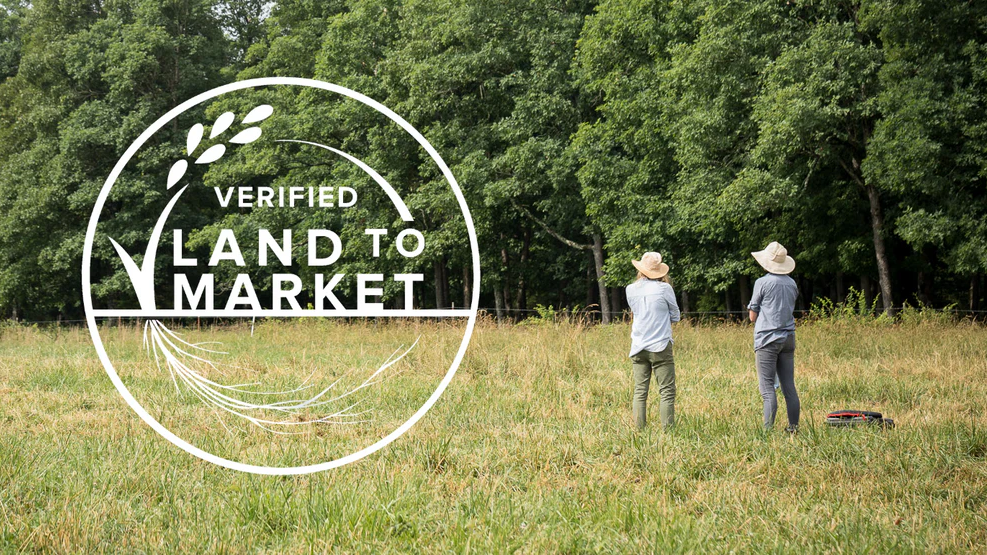Land to Market: Grass Roots Becomes Verified Member

At Grass Roots, we believe that regenerative agriculture through holistic land management is essential to being good stewards of this earth. Our farmers work hard to create a healthy future for this country and exceptional products for our customers. In order to recognize their efforts, we decided to go through the process of joining Land to Market—a body that verifies raw material production that shows positive ecological outcomes. And we’re excited to announce that we are now a member!
What is Land to Market?
Land to Market is spearheaded by the Savory Institute and is a program that connects the products of regeneratively farmed land to consumers. Not only does this highlight the work of the farmers—thereby creating awareness—but it also connects farmers to a wider audience of buyers who are looking for products produced with values that match their own.
The mission of Savory Institute—the organization that verifies the Land to Market standards—is to facilitate the large-scale regeneration of the world’s grasslands and the livelihoods of their inhabitants through holistic management. It does this through the recognition of the need for a synergy between grasslands and grazers.
With help from Michigan State University, Texas A&M, Ovis 21, The Nature Conservancy and others, The Institute has developed a program to connect farmers stewarding the relationship between grasslands and grazers with the end consumer. The goal is to give people the option to vote with their dollar to support land that is healing.
Meet: Ecological Outcome Verification (EOV) and Land to Market, the world’s first outcome-based verified regenerative solution for raw materials
Ecological Outcome Verification (EOV)
Land to Market’s program uses a method called Ecological Outcome Verification (EOV) to mark and measure the restoration of land. The indicators of health that EOV looks for are: water, carbon, biodiversity, and soil. These can be either lagging or leading indicators.
- A lagging indicator would be carbon sequestration. It takes a long time to show up and be measured in an environment.
- A leading indicator could be looking at the metabolism of the soil–how long it takes for animal waste to break down.
Each land area is looked at within its own context and compared only to itself—its natural history and biodiversity, carbon levels, and water and soil content. If a farm can measure both of these types of indicators for a long time, a more complete picture is created to lead a place to rejuvenation.
While EOV’s indicators are purely scientific, the stewardship plans its data help provide are centered around the tenants of holistic management (the decision-making process) to help ensure that the actions taken to restore the land and livelihoods are ecologically, socially and economically sound. The goal is to create net-positives within an ecosystem.
Each piece of land is different, and each EOV plan is unique to a specific location and tailored for each farm. What spells out health for a farm in Nevada doesn’t necessarily hold true for a farm in North Carolina. EOV offers custom plans of stewardship based on common principles and hard data for the greatest possible ecological impact.
To learn more about this ground-breaking and holistic approach to regenerative agriculture, you can find out more here.
Why Being Part of Land to Market Matters
As consumerism has grown over the years, the supply chain has become more exploitive and hard on the environment as the consumers’ increasing demands have added unmeasurable pressures. These pressures lead to poor choices that massively contribute to the climate crisis, and consumers don’t always know where their products are coming from.
Land to Market offers a solution to this problem by providing a system of traceability and accountability for all products within its network. Consumers can then decide what local product and economies they want to support.
And the products Land to Market supports are top quality, too—fit for even the most discerning gourmand—and offer health benefits beyond what can be found in the stores. For example, with regard to meat, studies have shown that pasture raised beef has 3 times more omega-3s, 60% lower omega-6s, 3 times more vitamin E, and 1.5 times more beta-carotene.
Land to Market is a win-win-win on all accounts: consumers can make an impact and have access to healthier and better products, farmers get the recognition they deserve and access to a larger purchasing power, and the environment is given the chance to regenerate.
Help make your impact today and support regenerative agriculture. Shop our selection here.



